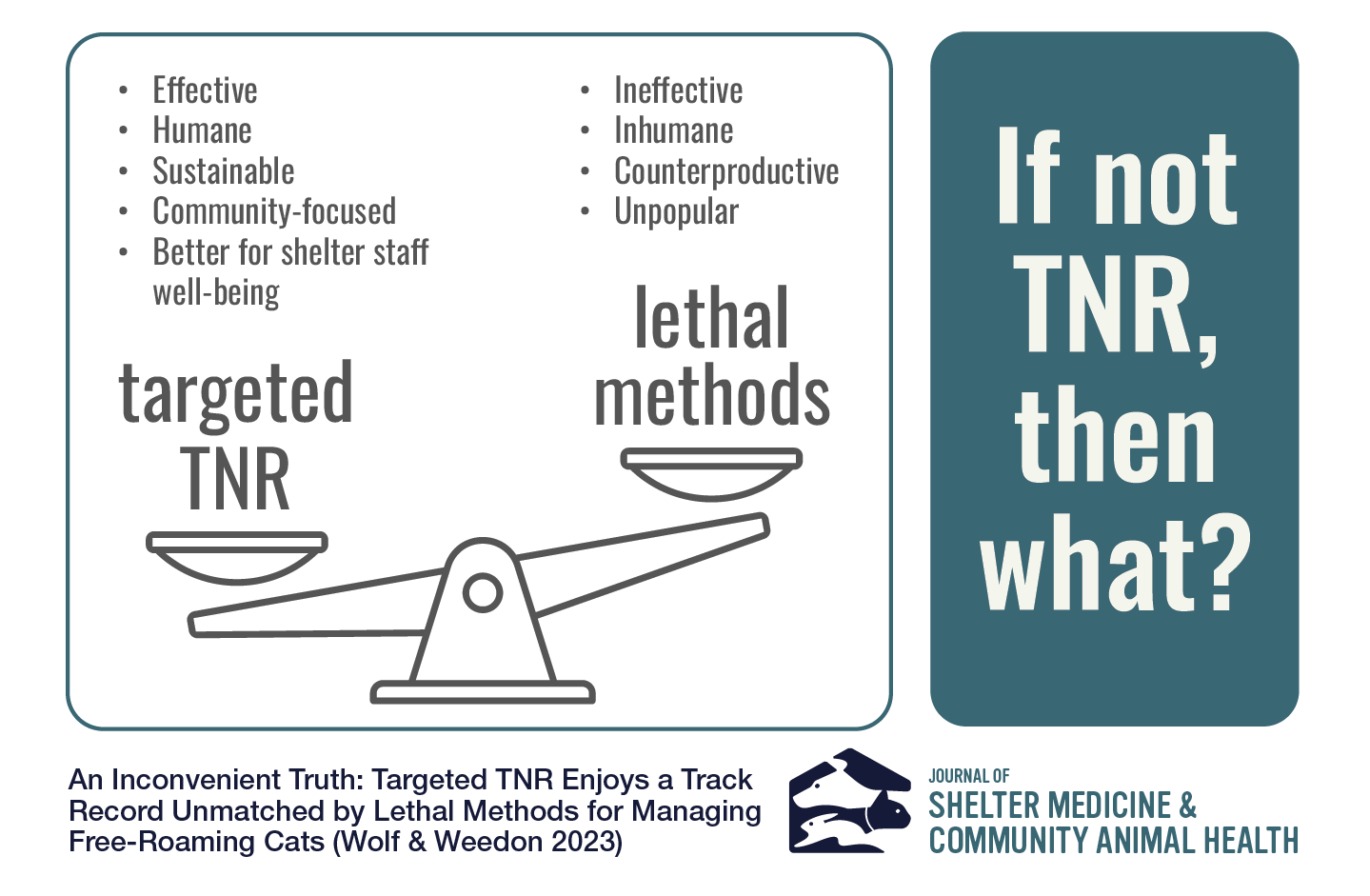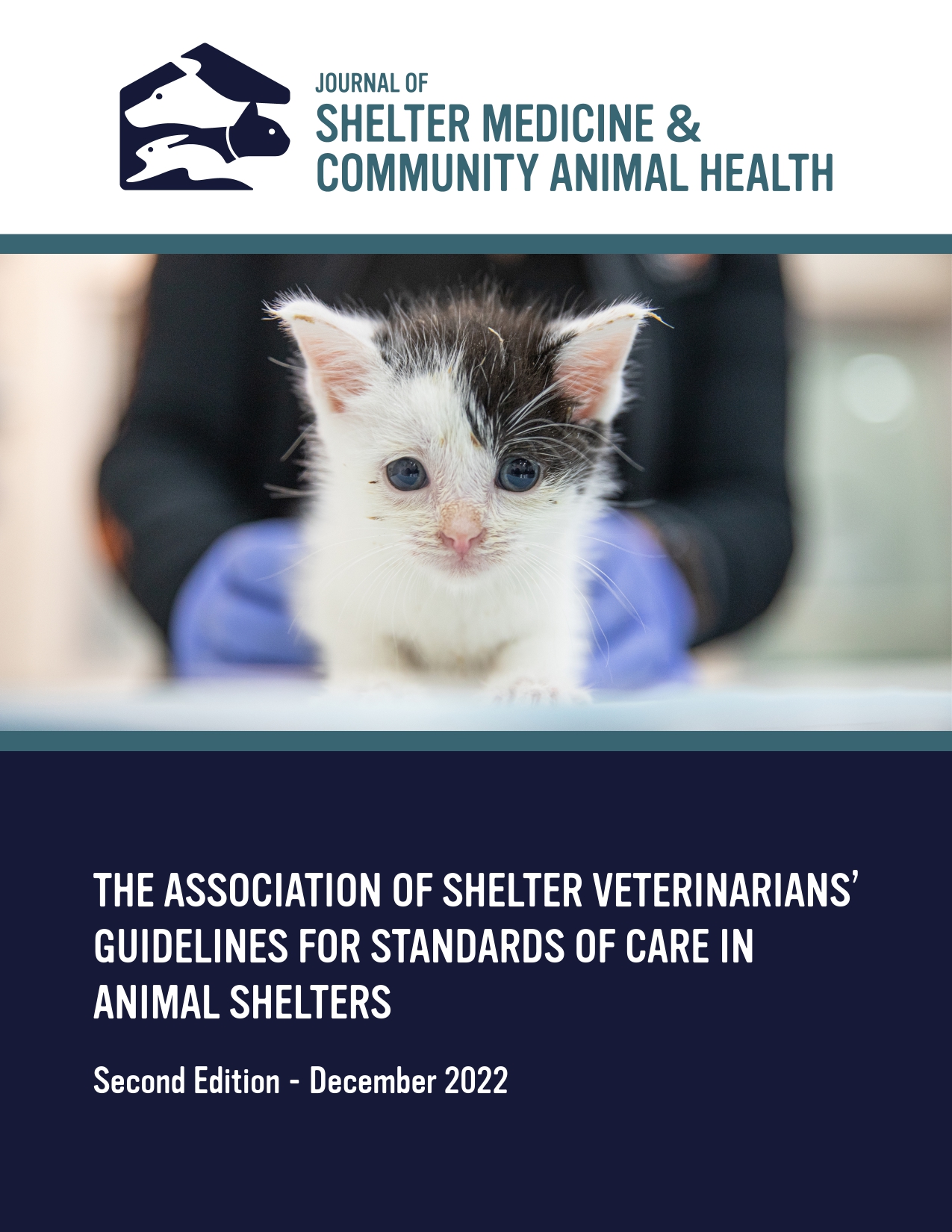An Inconvenient Truth: Targeted TNR Enjoys a Track Record Unmatched by Lethal Methods for Managing Free-Roaming Cats
DOI:
https://doi.org/10.56771/jsmcah.v2.68Keywords:
TNR, trap-neuter-return, free-roaming cats, community cats, feral catsDownloads
References
Edinboro CH, Watson HN, Fairbrother A. Association between a shelter-neuter-return program and cat health at a large municipal animal shelter. J Am Vet Med Assoc. 2016;248(3):298–308. doi: 10.2460/javma.248.3.298
Hamilton F. Implementing nonlethal solutions for free-roaming cat management in a county in the southeastern United States. Front Vet Sci. 2019;6:259. doi: 10.3389/fvets.2019.00259
Johnson KL, Cicirelli J. Study of the effect on shelter cat intakes and euthanasia from a shelter neuter return project of 10,080 cats from March 2010 to June 2014. PeerJ. 2014;2:e646. doi: 10.7717/peerj.646
Levy JK, Isaza NM, Scott KC. Effect of high-impact targeted trap-neuter-return and adoption of community cats on cat intake to a shelter. Vet J. 2014;201(3):269–274. doi: 10.1016/j.tvjl.2014.05.001
Kreisler RE, Cornell HN, Levy JK. Decrease in population and increase in welfare of community cats in a twenty-three year trap-neuter-return program in key Largo, FL: The ORCAT program. Front Vet Sci. 2019;6:7. doi: 10.3389/fvets.2019.00007
Kreisler RE, Pugh AA, Pemberton K, Pizano S. The impact of incorporating multiple best practices on live outcomes for a municipal animal Shelter in Memphis, TN. Front Vet Sci. 2022;9. https://www.frontiersin.org/articles/10.3389/fvets.2022.786866
Spehar DD, Wolf PJ. The impact of return-to-field and targeted trap-neuter-return on Feline intake and euthanasia at a municipal animal Shelter in Jefferson County, Kentucky. Animals. 2020;10(8):1395.
Lepczyk CA, Duffy DC, Bird DM, et al. A science-based policy for managing free-roaming cats. Biol Invasions. 2022;24:3693–3701. doi: 10.1007/s10530-022-02888-2
Lepczyk CA, Dauphiné N, Bird DM, et al. What conservation biologists can do to counter trap-neuter-return: Response to Longcore et al. Conserv Biol. 2010;24(2):627–629.
Lynn WS, Santiago-Ávila F, Lindenmayer J, Hadidian J, Wallach A, King BJ. A moral panic over cats. Conserv Biol. 2019;33(4):769–776. doi: 10.1111/cobi.13346
Baran BE, Allen JA, Rogelberg SG, et al. Euthanasia-related strain and coping strategies in animal shelter employees. J Am Vet Med Assoc. 2009;235(1):83–88. doi: 10.2460/javma.235.1.83
Scotney RL, McLaughlin D, Keates HL. A systematic review of the effects of euthanasia and occupational stress in personnel working with animals in animal shelters, veterinary clinics, and biomedical research facilities. J Am Vet Med Assoc. 2015;247(10):1121–1130. doi: 10.2460/javma.247.10.1121
Andrukonis A, Protopopova A. Occupational health of animal Shelter employees by live release rate, Shelter type, and euthanasia-related decision. Null. 2020;33(1):119–131. doi: 10.1080/08927936.2020.1694316
Monaghan H, Rohlf V, Scotney R, Bennett P. Compassion fatigue in people who care for animals: an investigation of risk and protective factors. Traumatology. Published online 2020:No Pagination Specified-No Pagination Specified. doi: 10.1037/trm0000246
Wolf PJ, Schaffner JE. The road to TNR: examining trap-neuter-return through the lens of our evolving ethics. Front Vet Sci. 2019;5:341. doi: 10.3389/fvets.2018.00341
Wolf PJ, Hamilton F. Managing free-roaming cats in U.S. cities: An object lesson in public policy and citizen action. J Urban Aff. 2020;44(2):221–242. doi: 10.1080/07352166.2020.1742577
Moulton C, Wright P, Rindy K. The role of animal shelters in controlling pet overpopulation. J Am Vet Med Assoc. 1991;198(7):1172–1176.
Courchamp F, Langlais M, Sugihara G. Cats protecting birds: modelling the mesopredator release effect. J Anim Ecol. 1999;68(2):282–292.
Fan M, Kuang Y, Feng Z. Cats protecting birds revisited. Bull Math Biol. 2005;67(5):1081–1106.
Smith RK, Pullin AS, Stewart GB, Sutherland WJ. Effectiveness of predator removal for enhancing bird populations. Conserv Biol. 2010;24(3):820–829. doi: 10.1111/j.1523-1739.2009.01421.x
Bester MN, Bloomer JP, Vam Aarde RJ, et al. A review of the successful eradication of feral cats from sub-Antarctic Marion Island, Southern Indian Ocean. S Afr J Wildl Res. 2002;32(1):65–73.
Cooper J, Marais AVN, Bloomer JP, Bester M. A success story: breeding of burrowing petrels (Procellariidae) before and after the eradication of feral cats Felis catus at Subantarctic Marion Island. Marine Ornithol. 1995;23(1):33–37.
Dilley BJ, Schramm M, Ryan PG. Modest increases in densities of burrow-nesting petrels following the removal of cats (Felis catus) from Marion Island. Polar Biol. 2017;40(3):625–637. doi: 10.1007/s00300-016-1985-z
Preston GR, Dilley BJ, Cooper J, et al. South Africa works towards eradicating introduced house mice from sub-Antarctic Marion Island: The largest island yet attempted for mice. In: Veitch CR, Clout MN, Martin AR, Russell JC, West CJ, eds. Island Invasives: Scaling up to Meet the Challenge: Proceedings of the International Conference on Island Invasives. Occasional Paper SSC no. 62. IUCN; 2019:40–46.
Schulz M, Robinson S, Gales R. Breeding of the Grey Petrel (Procellaria cinerea) on Macquarie Island: population size and nesting habitat. Emu. 2005;105(4):323–329. doi: 10.1071/MU04058
Brothers N, Bone C. The response of burrow-nesting petrels and other vulnerable bird species to vertebrate pest management and climate change on sub-Antarctic Macquarie Island. Papers Proc R Soc Tasmania. 2008;142(1):123–148. doi: 10.26749/rstpp.142.1.123
Bergstrom DM, Lucieer A, Kiefer K, et al. Indirect effects of invasive species removal devastate World Heritage Island. J Appl Ecol. 2009;46(1):73–81.
Lazenby BT, Mooney NJ, Dickman CR. Effects of low-level culling of feral cats in open populations: a case study from the forests of southern Tasmania. Wildl Res. 2015;41(5):407–420.
Palmas P, Gouyet R, Oedin M, et al. Rapid recolonisation of feral cats following intensive culling in a semi-isolated context. NeoBiota. 2020;63:177–200. doi: 10.3897/neobiota.63.58005
Zaunbrecher KI, Smith RE. Neutering of feral cats as an alternative to eradication programs. J Am Vet Med Assoc. 1993;203(3):449–452.
Hughes KL, Slater MR, Haller L. The effects of implementing a feral cat spay/neuter program in a Florida County Animal Control Service. J Appl Anim Welf Sci. 2002;5(4):285–298.
Levy JK, Gale DW, Gale LA. Evaluation of the effect of a long-term trap-neuter-return and adoption program on a free-roaming cat population. J Am Vet Med Assoc. 2003;222(1):42–46. doi: 10.2460/javma.2003.222.42
Mendes-de-Almeida F, Faria MCF, Landau-Remy G, et al. The impact of hysterectomy in an urban colony of domestic cats (Felis catus Linnaeus, 1758). Int J Appl Res Vet M. 2006;4(2):134–141.
Mendes-de-Almeida F, Remy GL, Gershony LC, Rodrigues DP, Chame M, Labarthe NV. Reduction of feral cat (Felis catus Linnaeus 1758) colony size following hysterectomy of adult female cats. J Feline Med Surg. 2011;13(6):436–440. doi: 10.1016/j.jfms.2011.02.001
Jessup DA. The welfare of feral cats and wildlife. J Am Vet Med Assoc. 2004;225(9):1377–1383. doi: 10.2460/javma.2004.225.1377
Marra PP, Santella C. Cat Wars: The Devastating Consequences of a Cuddly Killer. Princeton, NJ: Princeton University Press; 2016.
Benka VA, Boone JD, Miller PS, et al. Guidance for management of free-roaming community cats: a bioeconomic analysis. J Feline Med Surg. 2022;24(10):975–985. doi: 10.1177/1098612X211055685
Stoskopf MK, Nutter FB. Analyzing approaches to feral cat management—one size does not fit all. J Am Vet Med Assoc. 2004;225(9):1361–1364.
Nutter FB. Evaluation of a Trap-Neuter-Return Management Program for Feral Cat Colonies: Population Dynamics, Home Ranges, and Potentially Zoonotic Diseases. North Carolina State University; 2005. Accessed October 25, 2023. http://www.carnivoreconservation.org/files/thesis/nutter_2005_phd.pdf
Spehar DD, Wolf PJ. An examination of an iconic trap-neuter-return program: the Newburyport, Massachusetts case study. Animals. 2017;7(11):81. doi: 10.3390/ani7110081
Spehar DD, Wolf PJ. A case study in citizen science: The effectiveness of a trap-neuter-return program in a Chicago neighborhood. Animals. 2018;8(1):14. doi: 10.3390/ani7110081
Spehar DD, Wolf PJ. Back to school: an updated evaluation of the effectiveness of a long-term trap-neuter-return program on a university’s free-roaming cat population. Animals. 2019;9(10):768.
Spehar DD, Wolf PJ. The impact of targeted trap–neuter–return efforts in the San Francisco Bay area. Animals. 2020;10(11):2089. doi: 10.3390/ani10112089
Spehar DD, Wolf PJ. Integrated return-to-field and targeted trap-neuter-vaccinate-return programs result in reductions of feline intake and euthanasia at six municipal animal shelters. Front Vet Sci. 2019;6:77. doi: 10.3389/fvets.2019.00077
Ly LH, Protopopova A. Predictors of successful diversion of cats and dogs away from animal shelter intake: analysis of data from a self-rehoming website. Anim Welfare. 2023;32:e13. doi: 10.1017/awf.2023.8
Weiss E, Slater M, Lord L. Frequency of lost dogs and cats in the United States and the methods used to locate them. Animals. 2012;2(2):301–315.
AAFP. 2023 AAFP free-roaming cat position statement. J Feline Med Surg. 2023;25(5):1098612X231173791. doi: 10.1177/1098612X231173791
Neal SM, Wolf PJ. A cat is a cat: Attachment to community cats transcends ownership status. J Shelter Med Community Anim Health. 2023;2(1). Accessed October 3, 2023. https://jsmcah.org/index.php/jasv/article/view/62
Loss SR, Marra PP. Population impacts of free ranging domestic cats on mainland vertebrates. Front Ecol Environ. 2017;15(9):502–509. doi: 10.1002/fee.1633
Hughes KL, Slater MR. Implementation of a feral cat management program on a university campus. J Appl Anim Welf Sci. 2002;5(1):15–28.
Normand CM. Feral Cat Virus Infection Prevalence, Survival, Population Density, and Multi-Scale Habitat Use in an Exurban Landscape. Ann Arbor: M.S. Arkansas Tech University; 2014.
Rowan AN, Kartal T, Hadidian J. Cat demographics & impact on wildlife in the USA, the UK, Australia and New Zealand: facts and values. J Appl Anim Ethics Res. 2019. Accessed October 25, 2023. https://brill.com/view/journals/jaae/aop/article-10.1163-25889567-12340013.xml
Levy JK, Woods JE, Turick SL, Etheridge DL. Number of unowned free-roaming cats in a college community in the southern United States and characteristics of community residents who feed them. J Am Vet Med Assoc. 2003;223(2):202–205. doi: 10.2460/javma.2003.223.202
Lord LK. Attitudes toward and perceptions of free-roaming cats among individuals living in Ohio. J Am Vet Med Assoc. 2008;232(8):1159–1167. doi: 10.2460/javma.232.8.1159
APPA. 2015–2016 APPA National Pet Owners Survey. Stamford, CT: American Pet Products Association; 2017.
Silva-Rodríguez EA, Sieving KE. Influence of care of domestic carnivores on their predation on vertebrates. Conserv Biol. 2011;25(4):808–815. doi: 10.1111/j.1523-1739.2011.01690.x
Cove MV, Gardner B, Simons TR, Kays R, O’Connell AF. Free-ranging domestic cats (Felis catus) on public lands: estimating density, activity, and diet in the Florida Keys. Biol Invasions. 2018;20(2):333–344. doi: 10.1007/s10530-017-1534-x
Gunther I, Hawlena H, Azriel L, Gibor D, Berke O, Klement E. Reduction of free-roaming cat population requires high-intensity neutering in spatial contiguity to mitigate compensatory effects. Proc Natl Acad Sci-Biol. 2022;119(15):e2119000119. doi: 10.1073/pnas.2119000119
Hurley KF, Levy JK. Rethinking the animal shelter’s role in free-roaming cat management. Front Vet Sci. 2022;9:847081. doi: 10.3389/fvets.2022.847081
NACA. Animal Control Intake of Free-Roaming Cats. National Animal Care and Control Association; 2021. Accessed October 26, 2021. https://www.nacanet.org/animal-control-intake-of-free-roaming-cats/
Turner DC. Outdoor domestic cats and wildlife: how to overrate and misinterpret field data. Front Vet Sci. 2022;9. Accessed May 25, 2023. https://www.frontiersin.org/articles/10.3389/fvets.2022.1087907

Published
Issue
Section
License
Copyright (c) 2023 Peter J. Wolf, G. Robert Weedon

This work is licensed under a Creative Commons Attribution 4.0 International License.









